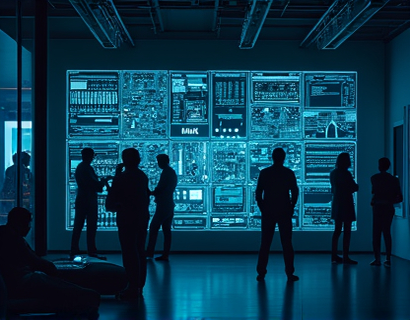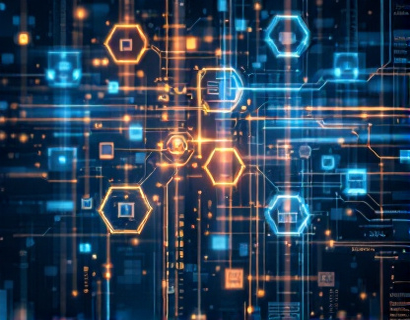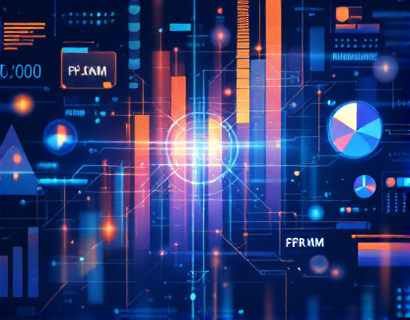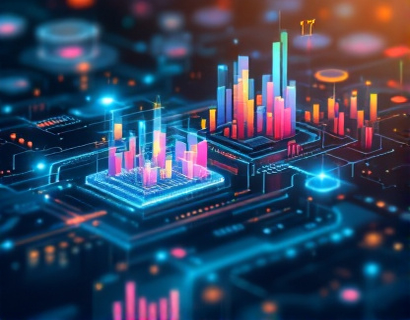Crypto and AI: Pioneering Next-Gen Digital Engagement for App Innovation
The intersection of blockchain technology and artificial intelligence (AI) is giving rise to a new era of digital engagement, particularly in the realm of application (app) innovation. This synergy is not just about combining two advanced technologies but about creating a transformative ecosystem that enhances user experiences, fosters growth, and redefines interactions in the digital space. This article delves into the profound impact of integrating blockchain and AI, exploring how these technologies are reshaping the way we engage with digital platforms and services.
Understanding the Basics: Blockchain and AI
To fully appreciate the potential of combining blockchain and AI, it's essential to understand each technology individually. Blockchain, at its core, is a decentralized ledger technology that ensures transparency, security, and immutability in transactions. It operates on a peer-to-peer network, eliminating the need for intermediaries and reducing the risk of fraud. On the other hand, AI refers to the simulation of human intelligence processes by machines, particularly computer systems. These processes include learning (the acquisition of information and rules for using it), reasoning (using rules to reach approximate or definite conclusions), and self-correction.
When these two technologies are merged, the result is a powerful toolset that can drive innovation and efficiency. Blockchain provides the secure and transparent foundation, while AI adds the intelligence and adaptability needed to process and analyze vast amounts of data. This combination is particularly beneficial in the context of app development and digital engagement, where user trust, data integrity, and personalized experiences are paramount.
Enhancing Security and Trust
One of the most significant advantages of integrating blockchain and AI in app innovation is the enhancement of security and trust. Blockchain's inherent properties make it an ideal platform for securing user data and ensuring the integrity of transactions. AI, with its advanced analytics and machine learning capabilities, can detect and mitigate potential security threats in real-time. This dual approach creates a robust defense mechanism against cyber threats, thereby increasing user confidence in digital platforms.
For instance, AI-driven algorithms can monitor blockchain networks for unusual patterns or anomalies, automatically triggering security protocols to prevent breaches. This proactive approach not only safeguards user data but also builds a reputation for reliability and trustworthiness, which is crucial for app adoption and user retention.
Personalized User Experiences
AI's strength lies in its ability to process and analyze large datasets to provide personalized experiences. When combined with blockchain, this capability is amplified. Blockchain ensures that user data is stored securely and transparently, giving users greater control over their information. AI can then use this data to create highly personalized and relevant experiences for each user, from tailored content recommendations to customized user interfaces.
For example, in a decentralized social media app, AI can analyze user interactions and preferences stored on the blockchain to curate a feed that is uniquely suited to each individual. This level of personalization not only enhances user satisfaction but also increases engagement and time spent on the platform.
Decentralized Identity Management
Another critical area where blockchain and AI converge is in decentralized identity management. Traditional identity verification processes are often centralized, vulnerable to breaches, and prone to misuse. By leveraging blockchain, identities can be stored and managed in a decentralized manner, giving users full control over their personal information. AI can enhance this process by verifying identities through biometric data and behavioral patterns, ensuring both security and convenience.
For instance, a decentralized identity system could use AI to authenticate a user's identity based on multiple factors, such as facial recognition, voice patterns, and transaction history stored on the blockchain. This multi-layered approach not only strengthens security but also streamlines the verification process, reducing friction for users.
Smart Contracts and Automated Engagements
Smart contracts, self-executing contracts with the terms directly written into code, are a cornerstone of blockchain technology. When combined with AI, smart contracts can automate complex interactions and engagements within apps, reducing the need for manual intervention and increasing efficiency. AI can optimize the execution of smart contracts by analyzing real-time data and making intelligent decisions.
Consider a decentralized marketplace where smart contracts handle transactions and dispute resolution. AI can monitor market conditions, user behavior, and contract parameters to ensure fair and efficient transactions. For example, if a seller fails to deliver a product, AI can automatically trigger a refund to the buyer and initiate a dispute resolution process, all within the smart contract framework.
Data Privacy and User Empowerment
Data privacy is a growing concern in the digital age, and the combination of blockchain and AI offers a promising solution. Blockchain's decentralized nature ensures that user data is not stored in a single, vulnerable location. AI can further enhance privacy by implementing advanced encryption techniques and zero-knowledge proofs, allowing users to prove ownership of data without revealing the data itself.
Users can grant or revoke access to their data with granular control, ensuring that their privacy is respected. AI can assist in managing these permissions and ensuring compliance with data protection regulations, such as GDPR. This empowerment gives users more control over their digital footprint, fostering a sense of trust and loyalty towards the platforms they use.
Fraud Detection and Prevention
Fraud is a persistent issue in digital transactions, and the integration of AI with blockchain can significantly reduce this risk. AI algorithms can analyze transaction patterns and user behavior to identify potential fraudulent activities in real-time. Blockchain's immutable ledger ensures that all transactions are recorded and cannot be altered, providing a transparent and auditable trail.
For instance, in a financial app, AI can monitor transactions for unusual activity, such as large sums being transferred to unknown addresses or frequent login attempts from different locations. If a potential fraud is detected, the system can automatically alert users and take preventive measures, such as temporarily locking the account or requiring additional verification.
Enhancing Content Creation and Distribution
In the realm of content creation and distribution, blockchain and AI can revolutionize how creators produce, monetize, and distribute their work. Blockchain provides a transparent and fair way to attribute and compensate creators, while AI can optimize content recommendation algorithms to maximize reach and engagement.
For example, a decentralized content platform can use blockchain to tokenize content, allowing creators to sell unique digital assets or subscriptions directly to fans. AI can analyze user preferences and content performance to recommend the most relevant and engaging content, ensuring that creators reach their target audience effectively. This synergy not only benefits creators but also enhances the overall user experience.
Challenges and Considerations
While the potential of combining blockchain and AI is vast, there are several challenges and considerations to address. Scalability remains a significant issue for blockchain technology, as many platforms struggle to handle high transaction volumes efficiently. AI algorithms require substantial computational resources, which can be costly and energy-intensive. Additionally, regulatory frameworks for both blockchain and AI are still evolving, and compliance can be complex.
To overcome these challenges, ongoing research and development are essential. Innovations in blockchain scalability, such as layer 2 solutions and sharding, can help address transaction throughput issues. For AI, advancements in edge computing and more efficient algorithms can reduce computational demands. Collaboration between technologists, policymakers, and industry stakeholders is crucial to create a supportive ecosystem for these technologies.
Future Prospects and Opportunities
The future of digital engagement through the integration of blockchain and AI is bright, with numerous opportunities for innovation and growth. As these technologies mature, we can expect to see more sophisticated applications in various industries, from healthcare and finance to education and entertainment.
For tech enthusiasts and early adopters, the intersection of blockchain and AI presents a fertile ground for exploration and contribution. By staying informed and engaged, individuals can play a pivotal role in shaping the next generation of digital platforms and services. The potential for creating more secure, personalized, and efficient digital experiences is immense, and the journey has just begun.










































